Aylin Yener
Task-Oriented Low-Label Semantic Communication With Self-Supervised Learning
May 26, 2025Abstract:Task-oriented semantic communication enhances transmission efficiency by conveying semantic information rather than exact messages. Deep learning (DL)-based semantic communication can effectively cultivate the essential semantic knowledge for semantic extraction, transmission, and interpretation by leveraging massive labeled samples for downstream task training. In this paper, we propose a self-supervised learning-based semantic communication framework (SLSCom) to enhance task inference performance, particularly in scenarios with limited access to labeled samples. Specifically, we develop a task-relevant semantic encoder using unlabeled samples, which can be collected by devices in real-world edge networks. To facilitate task-relevant semantic extraction, we introduce self-supervision for learning contrastive features and formulate the information bottleneck (IB) problem to balance the tradeoff between the informativeness of the extracted features and task inference performance. Given the computational challenges of the IB problem, we devise a practical and effective solution by employing self-supervised classification and reconstruction pretext tasks. We further propose efficient joint training methods to enhance end-to-end inference accuracy over wireless channels, even with few labeled samples. We evaluate the proposed framework on image classification tasks over multipath wireless channels. Extensive simulation results demonstrate that SLSCom significantly outperforms conventional digital coding methods and existing DL-based approaches across varying labeled data set sizes and SNR conditions, even when the unlabeled samples are irrelevant to the downstream tasks.
Providing Differential Privacy for Federated Learning Over Wireless: A Cross-layer Framework
Dec 05, 2024



Abstract:Federated Learning (FL) is a distributed machine learning framework that inherently allows edge devices to maintain their local training data, thus providing some level of privacy. However, FL's model updates still pose a risk of privacy leakage, which must be mitigated. Over-the-air FL (OTA-FL) is an adapted FL design for wireless edge networks that leverages the natural superposition property of the wireless medium. We propose a wireless physical layer (PHY) design for OTA-FL which improves differential privacy (DP) through a decentralized, dynamic power control that utilizes both inherent Gaussian noise in the wireless channel and a cooperative jammer (CJ) for additional artificial noise generation when higher privacy levels are required. Although primarily implemented within the Upcycled-FL framework, where a resource-efficient method with first-order approximations is used at every even iteration to decrease the required information from clients, our power control strategy is applicable to any FL framework, including FedAvg and FedProx as shown in the paper. This adaptation showcases the flexibility and effectiveness of our design across different learning algorithms while maintaining a strong emphasis on privacy. Our design removes the need for client-side artificial noise injection for DP, utilizing a cooperative jammer to enhance privacy without affecting transmission efficiency for higher privacy demands. Privacy analysis is provided using the Moments Accountant method. We perform a convergence analysis for non-convex objectives to tackle heterogeneous data distributions, highlighting the inherent trade-offs between privacy and accuracy. Numerical results show that our approach with various FL algorithms outperforms the state-of-the-art under the same DP conditions on the non-i.i.d. FEMNIST dataset, and highlight the cooperative jammer's effectiveness in ensuring strict privacy.
Adaptive Personalized Over-the-Air Federated Learning with Reflecting Intelligent Surfaces
Dec 04, 2024Abstract:Over-the-air federated learning (OTA-FL) unifies communication and model aggregation by leveraging the inherent superposition property of the wireless medium. This strategy can enable scalable and bandwidth-efficient learning via simultaneous transmission of model updates using the same frequency resources, if care is exercised to design the physical layer jointly with learning. In this paper, a federated learning system facilitated by a heterogeneous edge-intelligent network is considered. The edge users (clients) have differing user resources and non-i.i.d. local dataset distributions. A general non-convex learning objective is considered for the model training task(s) at hand. We augment the network with Reconfigurable Intelligent Surfaces (RIS) in order to enhance the learning system. We propose a cross-layer algorithm that jointly assigns communication, computation and learning resources. In particular, we adaptively adjust the number of local steps in conjunction with RIS configuration to boost the learning performance. Our system model considers channel noise and channel estimation errors in both the uplink (model updates) and downlink (global model broadcast), employing dynamic power control for both. We provide the convergence analysis for the proposed algorithms and extend the frameworks to personalized learning. Our experimental results demonstrate that the proposed algorithms outperform the state-of-the-art joint communication and learning baselines.
Low-Latency Task-Oriented Communications with Multi-Round, Multi-Task Deep Learning
Nov 15, 2024Abstract:In this paper, we address task-oriented (or goal-oriented) communications where an encoder at the transmitter learns compressed latent representations of data, which are then transmitted over a wireless channel. At the receiver, a decoder performs a machine learning task, specifically for classifying the received signals. The deep neural networks corresponding to the encoder-decoder pair are jointly trained, taking both channel and data characteristics into account. Our objective is to achieve high accuracy in completing the underlying task while minimizing the number of channel uses determined by the encoder's output size. To this end, we propose a multi-round, multi-task learning (MRMTL) approach for the dynamic update of channel uses in multi-round transmissions. The transmitter incrementally sends an increasing number of encoded samples over the channel based on the feedback from the receiver, and the receiver utilizes the signals from a previous round to enhance the task performance, rather than only considering the latest transmission. This approach employs multi-task learning to jointly optimize accuracy across varying number of channel uses, treating each configuration as a distinct task. By evaluating the confidence of the receiver in task decisions, MRMTL decides on whether to allocate additional channel uses in multiple rounds. We characterize both the accuracy and the delay (total number of channel uses) of MRMTL, demonstrating that it achieves the accuracy close to that of conventional methods requiring large numbers of channel uses, but with reduced delay by incorporating signals from a prior round. We consider the CIFAR-10 dataset, convolutional neural network architectures, and AWGN and Rayleigh channel models for performance evaluation. We show that MRMTL significantly improves the efficiency of task-oriented communications, balancing accuracy and latency effectively.
ProFL: Performative Robust Optimal Federated Learning
Oct 23, 2024Abstract:Performative prediction (PP) is a framework that captures distribution shifts that occur during the training of machine learning models due to their deployment. As the trained model is used, its generated data could cause the model to evolve, leading to deviations from the original data distribution. The impact of such model-induced distribution shifts in the federated learning (FL) setup remains unexplored despite being increasingly likely to transpire in real-life use cases. Although Jin et al. (2024) recently extended PP to FL in a straightforward manner, the resulting model only converges to a performative stable point, which may be far from optimal. The methods in Izzo et al. (2021); Miller et al. (2021) can find a performative optimal point in centralized settings, but they require the performative risk to be convex and the training data to be noiseless, assumptions often violated in realistic FL systems. This paper overcomes all of these shortcomings and proposes Performative robust optimal Federated Learning (ProFL), an algorithm that finds performative optimal points in FL from noisy and contaminated data. We present the convergence analysis under the Polyak-Lojasiewicz condition, which applies to non-convex objectives. Extensive experiments on multiple datasets validate our proposed algorithms' efficiency.
Next Generation Advanced Transceiver Technologies for 6G
Mar 25, 2024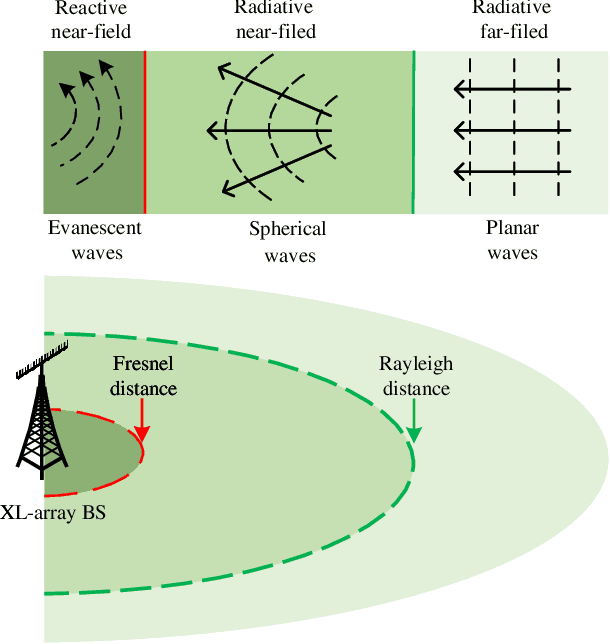

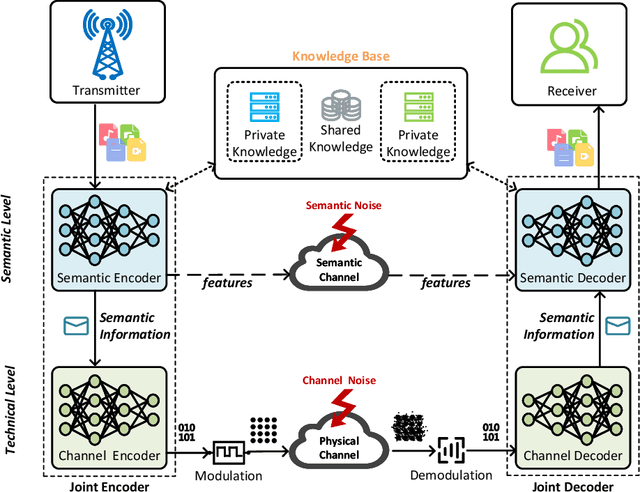

Abstract:To accommodate new applications such as extended reality, fully autonomous vehicular networks and the metaverse, next generation wireless networks are going to be subject to much more stringent performance requirements than the fifth-generation (5G) in terms of data rates, reliability, latency, and connectivity. It is thus necessary to develop next generation advanced transceiver (NGAT) technologies for efficient signal transmission and reception. In this tutorial, we explore the evolution of NGAT from three different perspectives. Specifically, we first provide an overview of new-field NGAT technology, which shifts from conventional far-field channel models to new near-field channel models. Then, three new-form NGAT technologies and their design challenges are presented, including reconfigurable intelligent surfaces, flexible antennas, and holographic multi-input multi-output (MIMO) systems. Subsequently, we discuss recent advances in semantic-aware NGAT technologies, which can utilize new metrics for advanced transceiver designs. Finally, we point out other promising transceiver technologies for future research.
Semantic Forwarding for Next Generation Relay Networks
Jan 30, 2024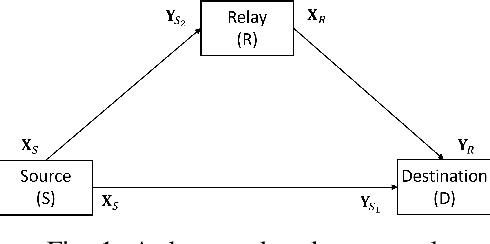

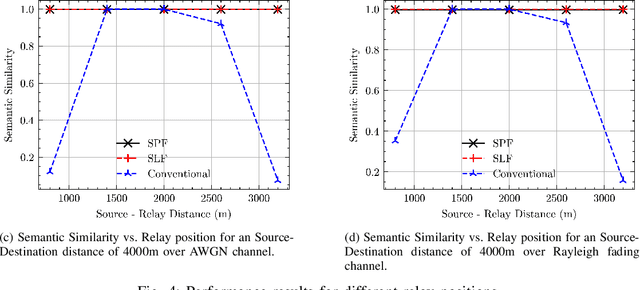
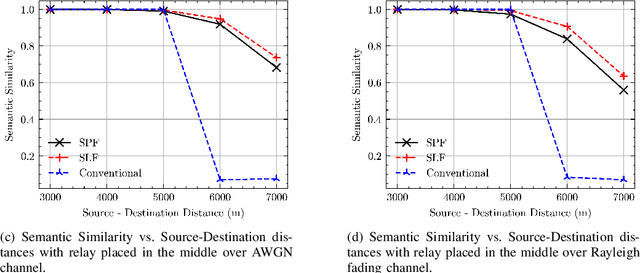
Abstract:We consider cooperative semantic text communications facilitated by a relay node. We propose two types of semantic forwarding: semantic lossy forwarding (SLF) and semantic predict-and-forward (SPF). Both are machine learning aided approaches, and, in particular, utilize attention mechanisms at the relay to establish a dynamic semantic state, updated upon receiving a new source signal. In the SLF model, the semantic state is used to decode the received source signal; whereas in the SPF model, it is used to predict the next source signal, enabling proactive forwarding. Our proposed forwarding schemes do not need any channel state information and exhibit consistent performance regardless of the relay's position. Our results demonstrate that the proposed semantic forwarding techniques outperform conventional semantic-agnostic baselines.
Personalized Over-the-Air Federated Learning with Personalized Reconfigurable Intelligent Surfaces
Jan 22, 2024Abstract:Over-the-air federated learning (OTA-FL) provides bandwidth-efficient learning by leveraging the inherent superposition property of wireless channels. Personalized federated learning balances performance for users with diverse datasets, addressing real-life data heterogeneity. We propose the first personalized OTA-FL scheme through multi-task learning, assisted by personal reconfigurable intelligent surfaces (RIS) for each user. We take a cross-layer approach that optimizes communication and computation resources for global and personalized tasks in time-varying channels with imperfect channel state information, using multi-task learning for non-i.i.d data. Our PROAR-PFed algorithm adaptively designs power, local iterations, and RIS configurations. We present convergence analysis for non-convex objectives and demonstrate that PROAR-PFed outperforms state-of-the-art on the Fashion-MNIST dataset.
Will 6G be Semantic Communications? Opportunities and Challenges from Task Oriented and Secure Communications to Integrated Sensing
Jan 03, 2024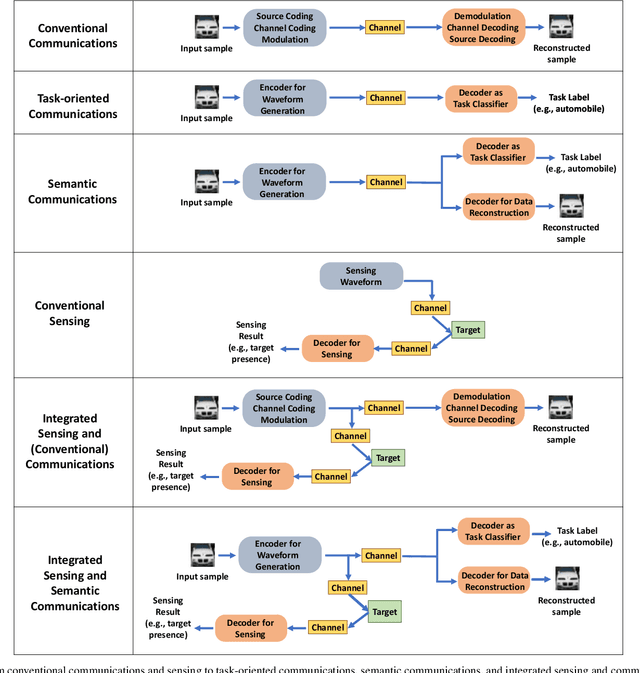
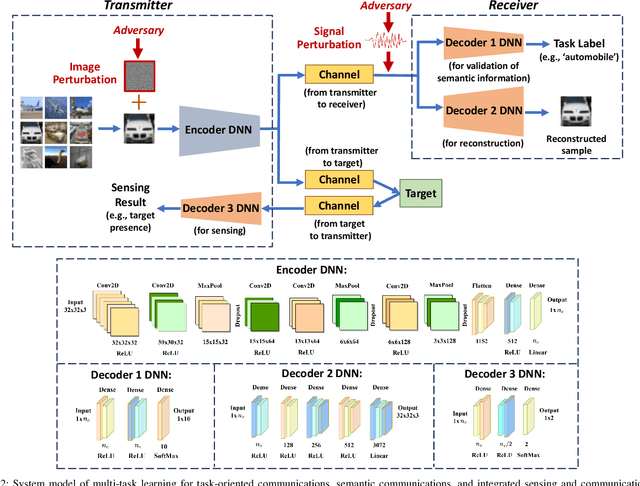
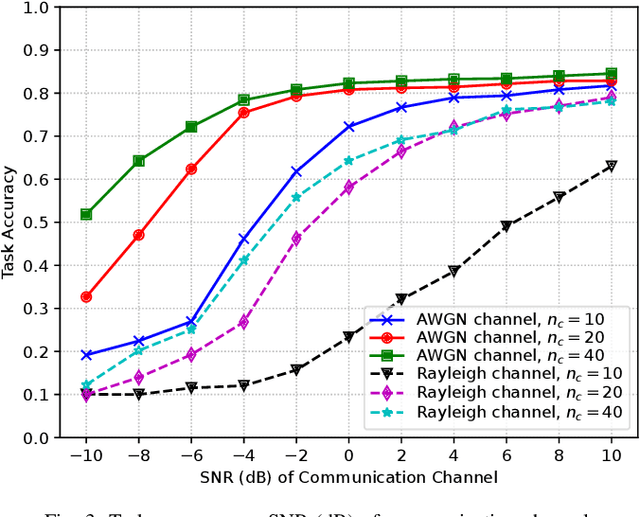
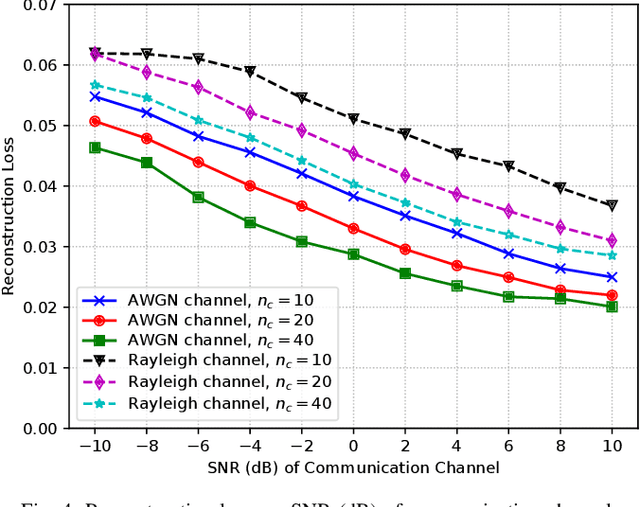
Abstract:This paper explores opportunities and challenges of task (goal)-oriented and semantic communications for next-generation (NextG) communication networks through the integration of multi-task learning. This approach employs deep neural networks representing a dedicated encoder at the transmitter and multiple task-specific decoders at the receiver, collectively trained to handle diverse tasks including semantic information preservation, source input reconstruction, and integrated sensing and communications. To extend the applicability from point-to-point links to multi-receiver settings, we envision the deployment of decoders at various receivers, where decentralized learning addresses the challenges of communication load and privacy concerns, leveraging federated learning techniques that distribute model updates across decentralized nodes. However, the efficacy of this approach is contingent on the robustness of the employed deep learning models. We scrutinize potential vulnerabilities stemming from adversarial attacks during both training and testing phases. These attacks aim to manipulate both the inputs at the encoder at the transmitter and the signals received over the air on the receiver side, highlighting the importance of fortifying semantic communications against potential multi-domain exploits. Overall, the joint and robust design of task-oriented communications, semantic communications, and integrated sensing and communications in a multi-task learning framework emerges as the key enabler for context-aware, resource-efficient, and secure communications ultimately needed in NextG network systems.
Joint Sensing and Task-Oriented Communications with Image and Wireless Data Modalities for Dynamic Spectrum Access
Dec 21, 2023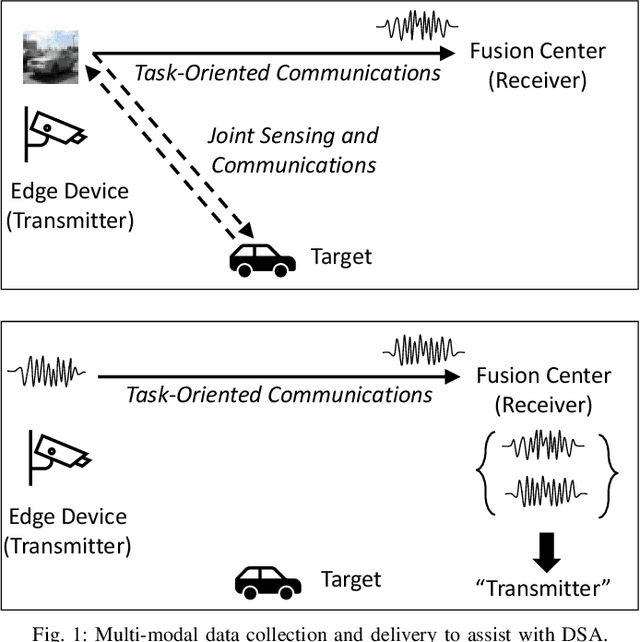
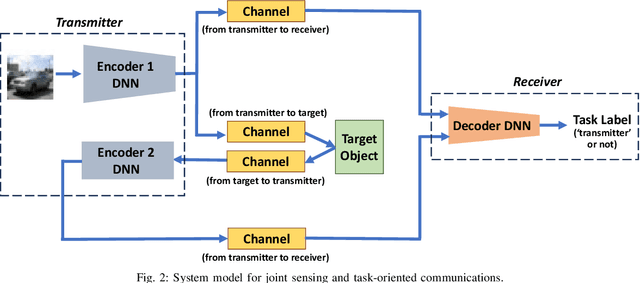

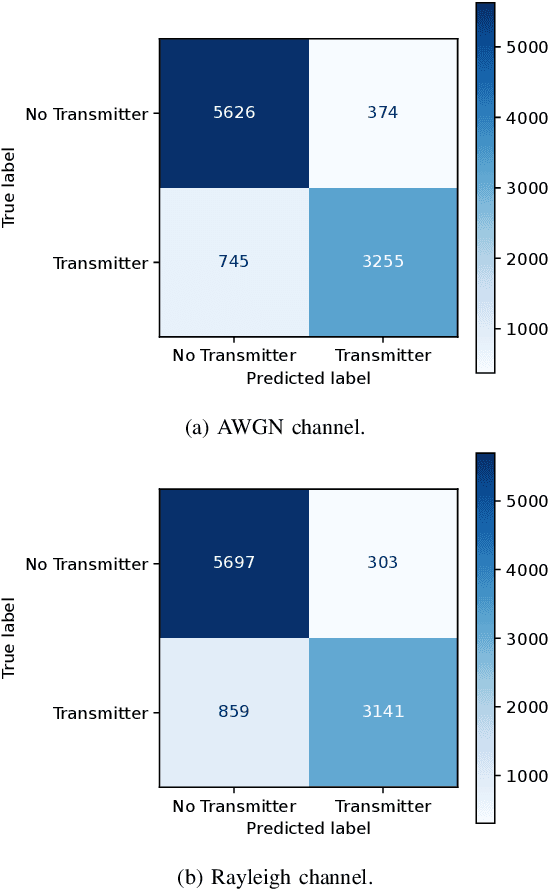
Abstract:This paper introduces a deep learning approach to dynamic spectrum access, leveraging the synergy of multi-modal image and spectrum data for the identification of potential transmitters. We consider an edge device equipped with a camera that is taking images of potential objects such as vehicles that may harbor transmitters. Recognizing the computational constraints and trust issues associated with on-device computation, we propose a collaborative system wherein the edge device communicates selectively processed information to a trusted receiver acting as a fusion center, where a decision is made to identify whether a potential transmitter is present, or not. To achieve this, we employ task-oriented communications, utilizing an encoder at the transmitter for joint source coding, channel coding, and modulation. This architecture efficiently transmits essential information of reduced dimension for object classification. Simultaneously, the transmitted signals may reflect off objects and return to the transmitter, allowing for the collection of target sensing data. Then the collected sensing data undergoes a second round of encoding at the transmitter, with the reduced-dimensional information communicated back to the fusion center through task-oriented communications. On the receiver side, a decoder performs the task of identifying a transmitter by fusing data received through joint sensing and task-oriented communications. The two encoders at the transmitter and the decoder at the receiver are jointly trained, enabling a seamless integration of image classification and wireless signal detection. Using AWGN and Rayleigh channel models, we demonstrate the effectiveness of the proposed approach, showcasing high accuracy in transmitter identification across diverse channel conditions while sustaining low latency in decision making.
 Add to Chrome
Add to Chrome Add to Firefox
Add to Firefox Add to Edge
Add to Edge